


 The
most commonly found shrimp species within live
rock are the mantis and pistol types. I would only consider the mantis
to be non-reef safe. Other types of shrimp are usually carried in as
commensals of corals species or hiding within the rock's crevices
posing no real threat to other livestock being kept
The
most commonly found shrimp species within live
rock are the mantis and pistol types. I would only consider the mantis
to be non-reef safe. Other types of shrimp are usually carried in as
commensals of corals species or hiding within the rock's crevices
posing no real threat to other livestock being kept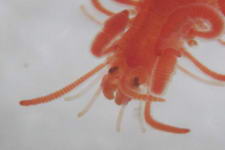
 Thankfully there has been enough identifications done, in large part
due to Leslie Harris, that with the
multitudes of worms species it has become easier to
identify most worm family & genus groups. For identification
purposes, the head structures are most important.
Thankfully there has been enough identifications done, in large part
due to Leslie Harris, that with the
multitudes of worms species it has become easier to
identify most worm family & genus groups. For identification
purposes, the head structures are most important. 
 With the exception of the commensal crabs I do
not introduce or allow to
remain, any of the crabs found hitch hiking in with live rock. Such
free ranging crabs including the hermits are just far too destructive
to the life within our reef aquariums.
With the exception of the commensal crabs I do
not introduce or allow to
remain, any of the crabs found hitch hiking in with live rock. Such
free ranging crabs including the hermits are just far too destructive
to the life within our reef aquariums. 
 When
snails are found as hitch hikers there is a very good chance that it
may be a predatory species. Identification may be difficult if one does
not know the features to examine or does not have reliable reference
material. This section also includes some nudibranch and sea
slug species.
When
snails are found as hitch hikers there is a very good chance that it
may be a predatory species. Identification may be difficult if one does
not know the features to examine or does not have reliable reference
material. This section also includes some nudibranch and sea
slug species.
 From
copepods to reproductive worm segments, there are few aquariums that
one can not sit in front of at night with a flashlight and a magnifying
glass and not discover a whole new tiny world if one takes the time to
look, closely. Nutritional content and how to
catch your own zooplankton from the wild.
From
copepods to reproductive worm segments, there are few aquariums that
one can not sit in front of at night with a flashlight and a magnifying
glass and not discover a whole new tiny world if one takes the time to
look, closely. Nutritional content and how to
catch your own zooplankton from the wild.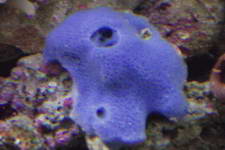
 It is very common for an established reef tank
with live rock to have
numerous sponge species just appear out of seemingly no where. While
some types will persist and remain, far to often you will see a sudden
growth of sponge which will linger for a few weeks and then disappear
as suddenly as it appeared.
It is very common for an established reef tank
with live rock to have
numerous sponge species just appear out of seemingly no where. While
some types will persist and remain, far to often you will see a sudden
growth of sponge which will linger for a few weeks and then disappear
as suddenly as it appeared. 
 From Foraminiferans, Sea Spiders,
Jellyfish, Ctenophors to Synaptids. This
page includes some of the more unusual, yet still common finds within
our systems.
From Foraminiferans, Sea Spiders,
Jellyfish, Ctenophors to Synaptids. This
page includes some of the more unusual, yet still common finds within
our systems.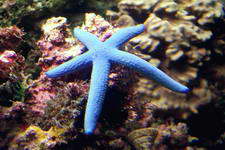
 Thankfully
starfish and sea urchins are fairly obvious as to what they are.
The
juveniles are most likely to be encountered as hitch hikers.
I do
not recommend purposely keeping starfish and sea urchins as they either
do not survive our systems or become dangerous to other aquarium
inhabitants along with growing too large for most aquarium systems.
Thankfully
starfish and sea urchins are fairly obvious as to what they are.
The
juveniles are most likely to be encountered as hitch hikers.
I do
not recommend purposely keeping starfish and sea urchins as they either
do not survive our systems or become dangerous to other aquarium
inhabitants along with growing too large for most aquarium systems.
 It
would be extremely rare to have a commonly kept species appear as a
hitch hiker. The vast majority of sea anemones found will
become
a threat either due to their rapid growth and spread or by their moving
through the aquarium and stinging sessile invertebrates that can not
get out of their way.
It
would be extremely rare to have a commonly kept species appear as a
hitch hiker. The vast majority of sea anemones found will
become
a threat either due to their rapid growth and spread or by their moving
through the aquarium and stinging sessile invertebrates that can not
get out of their way.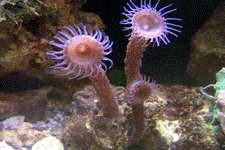
 It is not uncommon to find corals or polyps growing upon
live
rock,
some of which are common and easily identified. Those I will leave to
the coral pages and only high light the most commonly found species.
It is not uncommon to find corals or polyps growing upon
live
rock,
some of which are common and easily identified. Those I will leave to
the coral pages and only high light the most commonly found species.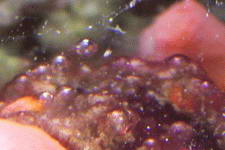
 There are numerous other organisms that may appear within our
systems which tend to become problematic as the aquarium conditions
that favored their appearance most always favors their becoming a pest.
There are numerous other organisms that may appear within our
systems which tend to become problematic as the aquarium conditions
that favored their appearance most always favors their becoming a pest.© 2016 ALL RIGHTS RESERVED
All Content
and Photographs are CopyRight Protected
and may not be used or reproduced elsewhere
without written permission of the authors.